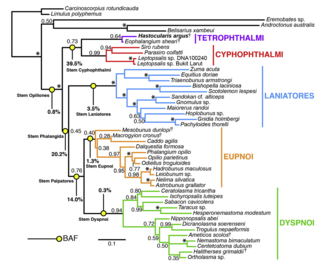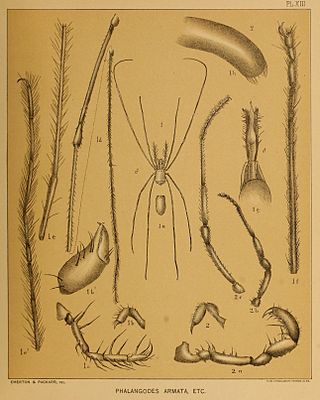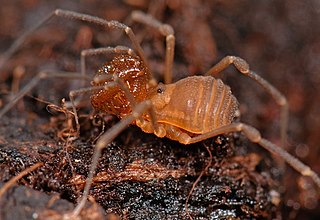
The Opiliones are an order of arachnids colloquially known as harvestmen, harvesters, harvest spiders, or daddy longlegs. As of April 2017, over 6,650 species of harvestmen have been discovered worldwide, although the total number of extant species may exceed 10,000. The order Opiliones includes five suborders: Cyphophthalmi, Eupnoi, Dyspnoi, Laniatores, and Tetrophthalmi, which were named in 2014.

Cyphophthalmi is a suborder of harvestmen, colloquially known as mite harvestmen. Cyphophthalmi comprises 36 genera, and more than two hundred described species. The six families are currently grouped into three infraorders: the Boreophthalmi, Scopulophthalmi, and Sternophthalmi.

The Sironidae are a family of harvestmen with more than 60 described species.

Ogoveidae is a family of harvestmen with three described species in one genus, Ogovea, which is found in equatorial West Africa.

The Neogoveidae are a family of harvestmen with 27 described species in eight genera. However, eight species of Huitaca, 17 species of Metagovea and 12 species of Neogovea are currently awaiting description.

The Pettalidae are a family of harvestmen with 75 described species in 10 genera. Several undescribed species are known or assumed in some genera.

Ischyropsalididae is a family of harvestmen with 35 described species in 3 genera, found in Europe and North America.

Opiliones are an order of arachnids and share many common characteristics with other arachnids. However, several differences separate harvestmen from other arachnid orders such as spiders. The bodies of opiliones are divided into two tagmata : the abdomen (opisthosoma) and the cephalothorax (prosoma). Unlike spiders, the juncture between the abdomen and cephalothorax is often poorly defined. Harvestmen have chelicerae, pedipalps and four pairs of legs. Harvestmen were traditionally thought to have two eyes, except in the case of eyeless species. Developmental genetic work has shown that living species retain up to six eyes, including one pair of rudimentary median eyes and one pair of rudimentary lateral eyes.

Harvestmen (Opiliones) are an order of arachnids often confused with spiders, though the two orders are not closely related. Research on harvestman phylogeny is in a state of flux. While some families are clearly monophyletic, that is share a common ancestor, others are not, and the relationships between families are often not well understood.
Zalmoxis is a genus of harvestmen, within the Zalmoxidae family. They are found in tropical Australia, Borneo, New Guinea, the Philippines and on Pacific islands.

Theromaster brunneus is a species of armoured harvestman in the family Travuniidae. It is found in North America.

Theromaster is a genus of armoured harvestmen in the family Cladonychiidae. There are at least two described species in Theromaster, found in the eastern United States.

Travunioidea is a superfamily of armoured harvestmen in the order Opiliones. There are 4 families and around 75 described species in Travunioidea.

Megacina is a genus of armoured harvestmen in the family Phalangodidae. There are at least four described species in Megacina.

Neosiro exilis is a species of mite harvestman in the family Sironidae. It is found in North America.

Phalangodes is a genus of armoured harvestmen in the family Phalangodidae. There is at least one described species in Phalangodes, P. armata.
Speleonychia is a genus of armoured harvestmen in the family Cladonychiidae. There is at least one described species in Speleonychia, S. sengeri. It is found in Washington state.

Cryptomastridae is a family of armoured harvestmen in the order Opiliones. There are two genera and four described species in Cryptomastridae, found in Oregon and Idaho.

Briggsus is a genus of armoured harvestmen in the family Cladonychiidae. There are about five described species in Briggsus, found in the coastal forests of Oregon and Washington.















